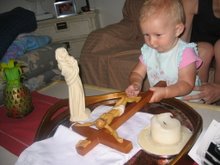Or rather, mongooses. These crafty critters litter the Hawaiian islands. Unless you have been to Hawaii or places endemic to mongooses, it's unlikely you have seen these little guys.
 They're a sort of hybrid creature. Mongooses were introduced in the Hawaiian islands in 1893 to kill the increasing rat populations. Unfortunately, the diurnal mongooses rarely encountered the nocturnal rats. Thanks to this ingenious species introduction, Hawaii regards both rats and mongooses as invasive species: they threaten wildlife, vegetation, and crops. Despite their unwelcome presence, I get a thrill to see them slinking around our house. The other day we were having a cup of the morning brew on our porch and Mary spotted a mongoose just a few feet away from us in the backyard. Sleek and brown, the mongoose crept among the rocks before sliding between the wiring of the fence. I wanted Maddy to see the mongoose to appreciate the interesting species. Unfortunately, she was more interested in the ant crawling across the porch. Oh, well. I will tell her later on that she saw them. My favorite mongoose experience occurred in the fall of 2006. I was going for a jog along the Diamond Head coast, just east of Waikiki. It's one of my favorite runs. The coast is populated with multi-million dollar castles. At the top of the hill, there are some superb look-out points. The sunrise over the eastern horizon is breathtaking. Anyhow, while resting at one of the look-outs, I spied a family of mongooses. The two parents had three baby mongooses. Since they are fast and secretive animals, it was neat to observe them interacting in their environment. After watching these animals in the wild, I get a kick out of the commercialized image of the ferocious and daring mongrel that Mongoose bikes depict.
They're a sort of hybrid creature. Mongooses were introduced in the Hawaiian islands in 1893 to kill the increasing rat populations. Unfortunately, the diurnal mongooses rarely encountered the nocturnal rats. Thanks to this ingenious species introduction, Hawaii regards both rats and mongooses as invasive species: they threaten wildlife, vegetation, and crops. Despite their unwelcome presence, I get a thrill to see them slinking around our house. The other day we were having a cup of the morning brew on our porch and Mary spotted a mongoose just a few feet away from us in the backyard. Sleek and brown, the mongoose crept among the rocks before sliding between the wiring of the fence. I wanted Maddy to see the mongoose to appreciate the interesting species. Unfortunately, she was more interested in the ant crawling across the porch. Oh, well. I will tell her later on that she saw them. My favorite mongoose experience occurred in the fall of 2006. I was going for a jog along the Diamond Head coast, just east of Waikiki. It's one of my favorite runs. The coast is populated with multi-million dollar castles. At the top of the hill, there are some superb look-out points. The sunrise over the eastern horizon is breathtaking. Anyhow, while resting at one of the look-outs, I spied a family of mongooses. The two parents had three baby mongooses. Since they are fast and secretive animals, it was neat to observe them interacting in their environment. After watching these animals in the wild, I get a kick out of the commercialized image of the ferocious and daring mongrel that Mongoose bikes depict.Current Affairs Commentary
Foreign ministers of the Organization of Islamic States suggested this week that the worst form of terrorism at present is Islamophobia. In the article the foreign ministers define Islamophobia as "a deliberate defamation of Islam and discrimination and intolerance against Muslims." First, I have to say that I am glad we are actually seeing definitions of a purported "phobia". We hear of Islamophobia, homophobia, and other phobia's on a daily basis and yet I see few self-contained definitions. Second, maybe the problem is syntactical at its foundation, but I thought that all phobia's were fears, not defamation, discrimination, or intolerance. Third, their definition is not self-contained: terms such as discrimination and intolerance are just as ambiguous as the phobia's themselves. It's curious that googling Islamophobia yields over a million sites while googling Catholic-phobia yields less than a hundred. Is it that more people hate or fear Islam than Catholicism? I think not. Yet, somehow, since Catholicism is sufficiently mainstream, there isn't a coined ism or phobia to express the defamation, discrimination or intolerance against Catholics. Or, perhaps this reality receives less attention because the MSM frowns on Islamophobia but not on Catholic phobia. A common definition of defamation is "false or unjustified injury of the good reputation of another." It's easier to label a contrarian as an Islamophobe than it is to prove the injury unjustified. Thought crimes have already become a reality in many countries in both the developed and developing world. I wonder how long freedom of speech will protect those who wish to think and express unpopular ideas. I don't condone defamation, discrimination, or intolerance. However, I do promote healthy debate and a robust critical analysis of everything. Why not? When dogmatism and political correctness squashes debate and critical analysis, we have reason to fear. Here is a thought-provoking site on Islam and the inter religious "debate".
Quick Thoughts on Today's Gospel

Readings Today -- You will weep and mourn, while the world rejoices
Christ is continually inviting us to be in the world but not of the world. Our mission is to make the best of what talents God has given us to become saints ourselves, and, to help others achieve this same goal. Space and time are contextual imperatives that are a necessary part of who we are. There is no way to escape these imperatives unless we live in a secluded setting, such as a monastery. We are called to use this context as a tool to achieve our mission. There is a problem when we use tool improperly and when the means becomes an end in and of itself. Life in the mainstream is not the calling of a Christian. To follow Christ means to go against the flow, to counter many aspects of the popular culture, to keep our sights focused on the Eternal. Christ ascended from this earth, leaving us. He has left us himself in the Church through the sacraments he instituted. Nevertheless, our hearts will never be complete until we rest in God. We will weep and mourn because we are left unsatisfied, groping for the infinite in a finite world.









